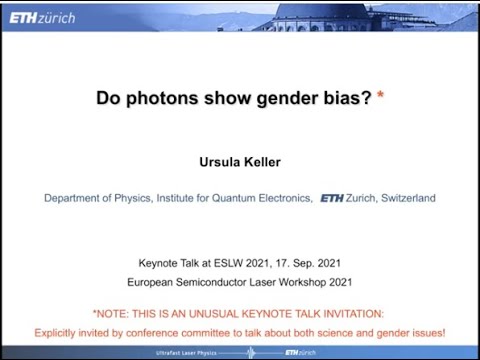Unusual keynote talk at an international scientific conference
“Do photons show gender bias?” The request of the organizers was to address both scientific and gender topic in this talk. This talk is online and you find more info here
Abstract:
external page https://eslw2021.telecom-paris.fr/program-advisory-committees/
Invited keynote talk:
external page https://eslw2021.telecom-paris.fr/keynote-and-invited-speakers/
Do photons show gender bias?
My journey in ultrafast lasers started almost 40 years ago, and I was convinced then that gender bias was no longer an issue. A child of the 60’s and 70’s, I could achieve anything based on my performance. After a PhD at Stanford and my own research at AT&T Bell Labs, I started as a tenured professor at ETH in 1993, where my group and I have continued to developed semiconductor saturable absorber mirror (SESAM) modelocked ultrafast lasers that have since extended short-pulsed laser performance by orders of magnitude in many dimensions, e.g. shorter pulse widths, higher average powers, higher pulse energies, and higher pulse repetition rates. Combining our knowledge of solid-state lasers and semiconductors, we have developed new classes of lasers such as the ultrafast VECSEL and the MIXSEL, recently extending the performance of these lasers towards the mid-infrared and dual-comb generation.
Somewhat to my surprise, I noticed my first issues of possible gender bias after arriving at ETH, and these issues continued to become more visible as I progressed in my career. As requested for this keynote talk, I will review some of my work but also some of the gender issues and challenges I have faced over the last few decades, with the goal of helping the next generation of engineers and scientists to better cope with this continuing challenge. I will show some examples from my personal experiences and also show measures be taken and being proposed to improve the situation.
My scientific career was experimental enough that building better lasers - and graduating almost 100 PhDs – avoided major career setbacks due to gender bias. But not without cost and effort (blood sweat and tears) from myself and others. Photons – short or long - don’t show gender bias, even if too many scientists still do.
Link for talk on youTube: external page https://youtu.be/I0emYhM0CHs
